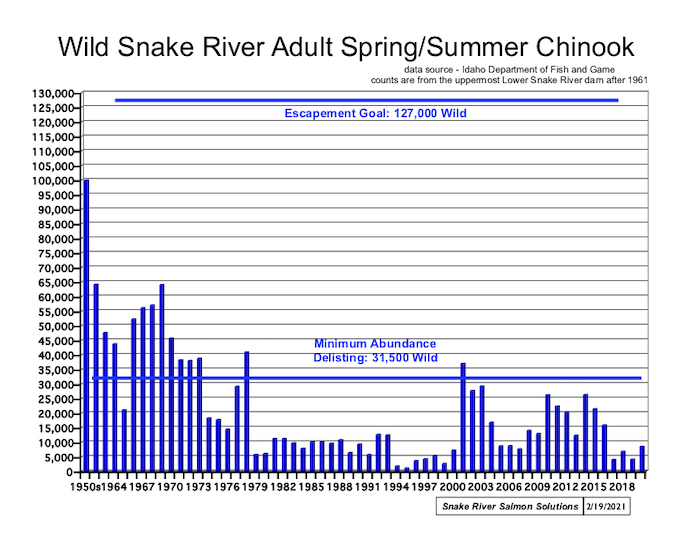forum
library
tutorial
contact

Ag Stakeholders Lead Dam Tour
as Federal Mediation Deadline Nears
by Matthew Weaver
Capital Press, August 24, 2023
|
the film forum library tutorial contact |

|
Ag Stakeholders Lead Dam Tour
by Matthew Weaver
|
The decline in salmon populations began in
1915 to 1922 -- before any dams were built.
 LEWISTON, Idaho -- Agricultural stakeholders talked with congressional staffers about the importance of the lower Snake River dams Aug. 23 even as they awaited the outcome of federal mediation.
LEWISTON, Idaho -- Agricultural stakeholders talked with congressional staffers about the importance of the lower Snake River dams Aug. 23 even as they awaited the outcome of federal mediation.
A coalition of environmental and fishing groups in 2020 sued the U.S. Army Corps of Engineers, Bureau of Reclamation and Bonneville Power Administration over their operation plan for the dams.
The White House Council on Environmental Quality and Federal Mediation and Conciliation Service are continuing mediation during a stay of the litigation. The stay was to end Aug. 31.
Anthony Pena, government relations manager of the Pacific Northwest Waterways Association, said a short-term extension of the stay is likely.
"Aug. 31 is around the corner and there's still a lot of work to be done," Pena said. "I don't know any specifics about any plans. We've been left out of a lot of these conversations."
The association's Inland Ports and Navigation Group is an intervenor defendant in the federal mediation.
Leslie Druffel, co-chair of the navigation group, and Kurt Miller, executive director of Northwest RiverPartners, an association that advocates for hydropower, told the Capital Press the previous week that they had for months been shut out of negotiations as intervenor defendants.
"There was an update, but I'm not bound by confidentiality to say there was nothing meaningful shared," Miller said.
"Still waiting," Druffel agreed.
"In my mind, it's not really a mediation if you only bring one side," said Tom Kammerzell, president of the waterways association, a Port of Whitman County commissioner and rancher in Colfax, Wash. "It's very frustrating for agriculture and all the interests that the Snake-Columbia river system have, to have what appears to be an agenda moving forth without being a part of it."
Legislative tour
The Washington Association of Wheat Growers led an all-day tour of 15 congressional staffers and five national agricultural organization reps Aug. 23, touring Lower Granite Dam in Almota, Wash., and visiting the Port of Lewiston, Idaho.
In an Aug. 22 letter to U.S. Department of Commerce Secretary Gina Raimondo and National Oceanic and Atmospheric Administration (NOAA) Administrator Richard W. Spinrad, the House Committee on Natural Resources said it continues to investigate NOAA Fisheries' reversal of its position regarding continued operation of the four lower Snake River dams.
"Your unresponsiveness to the Committee's document requests suggests that NOAA and NMFS are deliberately engaging in obstruction to frustrate the oversight power of Congress," the letter states. "This is unacceptable. The American public deserves transparency, and the Committee will not hesitate to utilize the tools at its disposal to administer effective oversight and fulfill the Committee's responsibility to the American public."
"It's very important to educate those that could potentially be decision-makers on our infrastructure," said Michelle Hennings, executive director of the association. "It's very valuable to bring people out to actually see in person the dams and our river system, and how important it is to keep our infrastructure in place."
Pre-dam decline
During a presentation at the Lower Granite Dam, Miller told the group that the decline in salmon populations began in 1915 to 1922 -- before any dams were built. The lower Snake River dams were built in the 1960s and 1970s.
Estimates for early salmon runs range from 6 million to 16 million, although Miller noted that there weren't any official salmon counts back then.
"Years before the first dam was built, we only were averaging less than 1 million salmon a year," he said. "It's very important to understand dams are not the reason salmon declined and they very well may not be the reason salmon aren't returning."
Related Sites:
Joint Motion to Extend Stay US District Court, 8/31/23
Idaho Dept. of Fish & Game v. NAT. MARINE FISHERIES US District Court Oregon, 3/28/94
learn more on topics covered in the film
see the video
read the script
learn the songs
discussion forum
